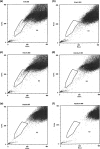Mouse sarcoma L1 cell line holoclones have a stemness signature
- PMID: 20546241
- PMCID: PMC6496761
- DOI: 10.1111/j.1365-2184.2010.00671.x
Mouse sarcoma L1 cell line holoclones have a stemness signature
Abstract
Accumulating data suggest that cancers contain a fraction of cells called cancer stem cells (CSCs), that may be responsible for upkeep and relapses of disease. In experimental settings, CSCs are regarded as most effective at tumour initiation in in vivo assays. Since the first isolation of cancer stem cells from acute myeloid leukaemia in 1994, cancer stem cells have been identified in human solid tumours and they have also been found in the established cell lines, based on ability of CSCs to form in vitro colonies of a specific morphology, called holoclones. Our study examined the ability of a mouse sarcoma cell line, derived from a lung metastasis of a BALB/c mouse and established as a stably growing line (L1), to produce holoclones in vitro. We aimed to verify a stemness signature of the holoclone cells. The L1 cell line was found to form holoclone colonies in vitro, which were shown to contain a percentage of CSC-like cells. A fraction of the L1 cells was able to repopulate the original cell line, and presented an increased clonogenic and metastatic potential (18th passage). In addition, MTT assay and flow cytometry of the side population fraction revealed that these cells were more resistant to chemotherapeutic drugs than the original cell line, and over-expressed the anti-apoptotic genes, GRP78 and GADD153. We conclude that mouse L1 sarcoma cell line contains CSC-like cells.
Figures



References
-
- Zhou J, Zhang Y (2008) Cancer stem cells. Models, mechanism and implication for improved treatment. Cell Cycle 7, 1360–1370. - PubMed
-
- Adams JM, Strasser A (2008) Is tumor growth sustained by rare cancer stem cells or dominant clones? Cancer Res. 68, 4018–4021. - PubMed
-
- Lapidot T, Sirard C, Vormoor J, Mudroch B, Hoang T, Cacres‐Cortes J et al. (1994) A cell initiating human myeloid leukemia after transplantation into SCID mice. Nature 367, 645–648. - PubMed
MeSH terms
Substances
LinkOut - more resources
Full Text Sources
Other Literature Sources
Medical
Research Materials
Miscellaneous

